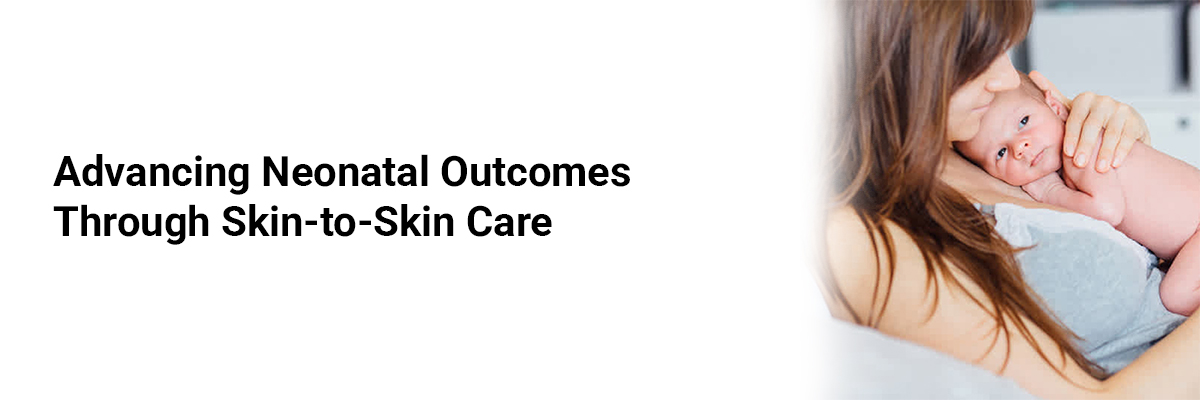
Advancing Neonatal Outcomes through Skin-to-Skin Care
Skin-to-skin care
(SSC), also referred to as kangaroo care (KC), is a recognized best practice
during the neonatal period, with extensive evidence supporting its critical role
in promoting optimal physiological, developmental, and psychosocial outcomes(1). SSC facilitates the newborn's adaptation to postnatal
life, supports the initiation and establishment of human milk feeding, fosters
parent–infant bonding, and enhances both neurodevelopment and physiological
stability(1,2).Initiation of SSC should occur immediately following
birth, regardless of the mode of delivery, vaginal or caesarean(3). The newborn is placed in a prone position directly on
the birthing parent's bare chest or abdomen, ensuring no clothing or barriers
interfere with direct skin contact. Unless the infant requires advanced
neonatal resuscitation, uninterrupted SSC should continue for a minimum of one
hour post-delivery. This duration coincides with the newborn’s progression
through innate behavioural stages culminating in the first breastfeeding
attempt (1).
To optimize
neonatal adaptation and the initiation of human milk feeding, SSC should be
prioritized with the birthing parent(1,4,5). However, if the birthing parent is medically
unstable, another individual designated by the parent or family may assume SSC
responsibilities. The practice confers multiple benefits, including reduced
neonatal pain and stress, improved parent-infant attachment, enhanced
neurological development, and positive impacts on parental mental well-being.
SSC is effective in both clinical and home environments and should be sustained
after hospital discharge with continued education and support provided by the
healthcare team(1,6).
Recent evidence
syntheses have prompted the World Health Organization (WHO) to recommend
initiating SSC as soon as possible post-birth, with prolonged daily
contact—ideally 8 hours or more, and up to 24 hours per day when feasible(6). The healthcare team plays a pivotal role in
promoting and facilitating SSC through culturally sensitive education,
provision of appropriate resources and equipment, and support tailored to the unique
needs of each family. Importantly, SSC should be encouraged for all infants,
irrespective of their feeding modality or clinical care requirements(1,7,8).
Impact of SSC on Breastfeeding and Human Milk Feeding Outcomes
Robust evidence
from randomized controlled trials (RCTs) and systematic reviews strongly
supports the positive impact of SSC on a wide range of human milk feeding
outcomes in both term and preterm infants. For late preterm infants, SSC has
been consistently associated with increased rates of exclusive breastfeeding at
hospital discharge and up to one month postpartum, as well as improved rates of
any breastfeeding at 1 to 4 months of age (9).Systematic reviews and meta-analyses indicate that
SSC, particularly in neonatal intensive care settings, significantly enhances
the likelihood of exclusive breastfeeding at discharge and during follow-up
intervals at 1, 3, and 4 months(1,2,10,11). Notably, evidence suggests a dose–response
relationship between SSC duration and breastfeeding outcomes, particularly
among preterm infants. Greater cumulative exposure to SSC during
hospitalization correlates with improved human milk feeding outcomes (1,2,12).Even brief SSC sessions of up to one hour have been
shown to extend the overall duration of any breastfeeding. Furthermore, SSC is
associated with increased volumes of expressed human milk and plays a critical
role in supporting infants’ transition from enteral (e.g., tube) feeding to
direct breastfeeding. As such, SSC should be regarded as an essential component
of postnatal care, with far-reaching implications for infant nutrition and
parental health(1).
References:
1. Altit
G, Hamilton D, O’Brien K. Skin-to-skin care (SSC) for term and preterm infants.
Paediatr Child Health. 2024 Jul 1;29(4):238–45.
2. Protecting, promoting and supporting
breastfeeding: the baby-friendly hospital initiative for small, sick and
preterm newborns [Internet]. [cited 2025 May 29]. Available from:
https://www.who.int/publications/i/item/9789240005648
3. WHO recommendations for care of the
preterm or low-birth-weight infant [Internet]. [cited 2025 May 29]. Available
from: https://www.who.int/publications/i/item/9789240058262
4. The nine stages of skin‐to‐skin:
practical guidelines and insights from four countries - Brimdyr - 2020 -
Maternal & Child Nutrition - Wiley Online Library [Internet]. [cited 2025
May 29]. Available from: https://onlinelibrary.wiley.com/doi/10.1111/mcn.13042
5. Early skin‐to‐skin contact for mothers
and their healthy newborn infants - Moore, ER - 2016 | Cochrane Library
[Internet]. [cited 2025 May 29]. Available from:
https://www.cochranelibrary.com/cdsr/doi/10.1002/14651858.CD003519.pub4/full
6. WHO recommendations for care of the
preterm or low-birth-weight infant [Internet]. [cited 2025 May 29]. Available
from: https://www.who.int/publications/i/item/9789240058262
7. Canada PHA of. Chapter 6: Breastfeeding
[Internet]. 2018 [cited 2025 May 29]. Available from:
https://www.canada.ca/en/public-health/services/publications/healthy-living/maternity-newborn-care-guidelines-chapter-6.html
8. Hubbard JM, Gattman KR. Parent–Infant
Skin-to-Skin Contact Following Birth: History, Benefits, and Challenges.
Neonatal Netw. 2017 Jan 1;36(2):89–97.
9. Moore ER, Bergman N, Anderson GC,
Medley N. Early skin‐to‐skin contact for mothers and their healthy newborn infants
- Moore, ER - 2016 | Cochrane Library. [cited 2025 May 29]; Available from:
https://www.cochranelibrary.com/cdsr/doi/10.1002/14651858.CD003519.pub4/full
10. Kangaroo Mother Care and Neonatal
Outcomes: A Meta-analysis | Pediatrics | American Academy of Pediatrics
[Internet]. [cited 2025 May 29]. Available from:
https://publications.aap.org/pediatrics/article-abstract/137/1/e20152238/52828/Kangaroo-Mother-Care-and-Neonatal-Outcomes-A-Meta?redirectedFrom=fulltext
11. Organization WH, Fund (UNICEF) UNC. Implementation
guidance: protecting, promoting and supporting breastfeeding in facilities
providing maternity and newborn services: the revised baby-friendly hospital
initiative [Internet]. World Health Organization; 2018 [cited 2025 May 29].
Available from: https://iris.who.int/handle/10665/272943
12. Skin‐to‐skin contact is associated with
earlier breastfeeding attainment in preterm infants - Oras - 2016 - Acta
Paediatrica - Wiley Online Library [Internet]. [cited 2025 May 29]. Available
from: https://onlinelibrary.wiley.com/doi/10.1111/apa.13431













Please login to comment on this article